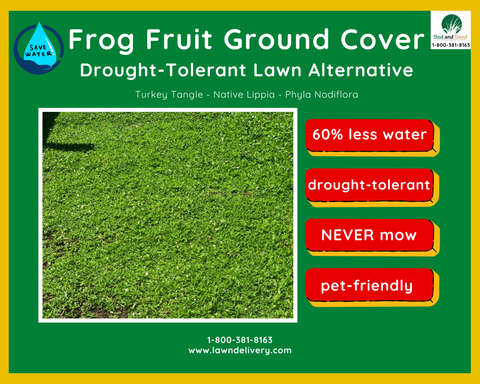Best Looking Native Ground Cover
Posted by George Bravos on
Ground Cover
Native lawn areas that use ground covers bring benefits such as seasonal flowers and life back to what may have been a former sod lawn. With native ground covers, the local ecosystem will thrive. For instance, a native lawn is able to carry our natural processes such as helping insects and plants through plant pollination as well as provide food for butterflies, bees, many insects and other small critters. With increased drought tolerance, a native ground cover will also help ease the maintenance a yard may typically demand while providing the best environment.
Lippia Ground Cover
Lippia ground covers are a great way to have a native lawn that is low-to-the-ground and self-repairing without the need for weekly or bi-weekly mowing. Sod and Seed, Inc. Lippia test plots have never been mowed in over 4 years and continue to grow low to the ground with conditions such as direct sunlight and heat.

A ground cover also provides protection from soil erosion and cools the surrounding area while filtering out dust particles. Approximately 1,000 square feet of ground cover produces enough oxygen for a family of four for one year.
A Ground Cover For Direct Sun That Saves Water
Different ground covers all have different needs and benefits. For example, our ground cover lawn alternative, frog fruit plugs are made to withstand direct sun. A ground cover mimics a lawn's low growth and provides a safe area to play on. Additionally, our alternative ground covers bloom flowers seasonally, though allowing them to bloom is optional. Some lawns are mowed to remain flowerless because they attract pollinators such as bees. Some folks do not wish for the extra company for reasons such as bee allergies and choose to mow Frog Fruit seasonally to avoid flowering. A native ground cover also saves over 50% of water usage versus a traditional sod lawn. Phyla nodiflora, or Frog Fruit ground cover, is a great option for direct sun areas and conserving water.
Native Ground Cover and Hybrid Ground Cover
A native ground cover like Phyla Nodiflora, or Frog Fruit, is great for wide areas in which seeding is okay. The flowers on the ground cover produce seeds and help repair damaged areas. The native ground cover may sprout up in other areas as well with seeds spreading through heavy winds. The Native version of Lippia has not been modified in any way and comes in plug form. The California Native Lippia plugs thrive in warm weather and tend to slow down during the winter, similar to Bermuda grass growth. Although Frog Fruit ground cover, or Phyla Nodiflora ground cover, prefers warm climate and sunny conditions, it is an evergreen plant so it will stay green all year as long as weather permits. Due to Native Frog Fruit ground cover having so many ways to reproduce, it is considered invasive, though the seed is not viable.
Phyla Nodiflora Common Names
Direct Sun Ground Cover

Ground Cover Plug Form
Native Ground Cover
Ground Cover Plugs and Sod
Share this post
- 0 comment
- Tags: bermuda grass, bermuda grass sod, best ground cover, best groundcover, Best Looking Native Ground Cover, best sod, best sod for Sacramento, cost of ground cover, frog fruit, frog fruit for sale, frog fruit ground cover, frog fruit ground cover pricing, frog fruit sale, frogfruit, full sun ground cover, grass sod, ground cover, ground cover cost, ground cover delivery, ground cover direct sun, ground cover for sale, ground cover ideas, ground cover lippia, ground cover native, ground cover pets, ground cover plugs, ground cover plugs near me, ground cover price, ground cover pricing, ground cover sacramento, ground cover sf, ground cover sod, ground cover sunny, Hybrid Ground Cover, Lawn delivery, lawn near me, lippia for sale, Lippia Ground Cover, lippia ground cover cost, lippia price, lippis for sale, native ground cover, native ground cover plugs, native ground cover seed, native plant, native plant nursery, native plants, native plants near me, native sod, nodiflora ground cover, organic ground cover, organic native plants, phlya lippia, picture of ground cover lawn, plugs near me, pricing of sod near me, San Francisco sod, seed, Sod and Seed, sod cost, sod for sale, sod lawn, Sod pricing, sod reviews, where to buy sod


